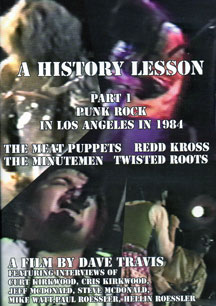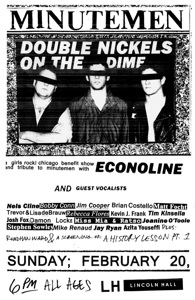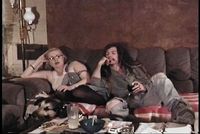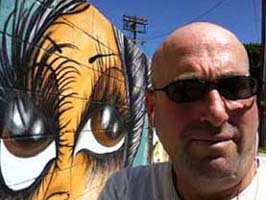
Interview with Dave Travis
A History Lesson Part 1
By Christopher Duda
(SugarBuzz Hell)
SugarBuzz Magazine
Punk is not really a style of music. It was more like a state of mind. -Mike Watt
1. What barriers were there in creating this film?
Clearances, Ignorance, Time, Money, Inertia
My biggest barrier was shooting footage and then trying to get people to sign releases 25 years later. I started A History Lesson by editing the first thirty bands I had shot together into a 30 band, 3-hour compilation. Then I found a lawyer to tell me how to legally release it. He advised me that I would never get it cleared and that I should pick a top ten and then re-edit. I re-edited the movie into a 12 band, 2-hour version. I then took it to a lawyer who gave me the paperwork to clear it. I had to find each band member from each band and get him or her to sign a release and also get sync licenses from the music publishing companies. I was only able to clear 25% of the bands so then I re-cut it again into a third version with the four bands, who self selected, in an hour. This process took two and a half years. It took longer to clear the final version of the movie then it did to edit it.
2. When can we expect part 2 to come  out?
out?
Hopefully, by the end of the year. More realistically 2012.
3. Will your approach to compiling it be any different?
Yes, for A History Lesson part 1. I started by digitizing the first thirty bands I taped in 1983-1984. Then I started editing them together. This was my first time doing non-linear editing. In the 1980’s and 1990’s I was doing videotape editing, I was teaching myself Final Cut as I was doing this project. Also, I definitely learned my lesson to Clear First, Edit Second. I now have a better understanding of the process from start to end so things should go more efficiently.
4. What was left out of the film that you would have liked to include?
The Meat Puppets show at Perkins Palace was with Black Flag. It is in my opinion one of Black Flags best shows. It is the My War Tour. Awesome Kira Roessler and Bill Stevenson rhythm section. Really heavy performances by Greg Ginn and Henry Rollins. I wish that could have been included, hopefully it will be in a future release.
5. When did you initially pick up a video recorder? What was the original footage shot on (was it the size of an elephant foreskin wallet-when rubbed it turns into a  suitcase!?)
suitcase!?)
I originally started shooting video in 1983. I started by making a short movie with my high school friends the Waco brothers from the band Armed Response. We watched it amongst our friends. Then one of my friends from school said that his brother was putting on a punk show at the West L.A. Federal Building and he wanted me to videotape. This was with Francis X and the Bushmen, Stukas over Bedrock, and Stalag 13. I made a copy for Francis X and then he invited me to video tape them at the Cathay de Grande. After that I could tape at the Cathay de Grande and soon started taping at other venues.
This was before the time of camcorders. I shot with a camera attached by a cable to a home VCR that I had in a backpack. This was plugged into a lighting battery belt that I had around my waist.
6. Did you hang out with Zappa and Pryor’s daughter in high school?
When I was in elementary school I lived in the Hollywood Hills. In my second grade class was Frank Zappa and Richard Pryor’s daughters. I did not appreciate the star-studdedness of this at the time. This was when Yellow Snow was a popular song. We lived down the street from the Zappa’s and I would skateboard with Dweezil on occasion but did not hang out with them that much. When I was in eighth grade my family moved to Pacific Palisades in West L.A. so I did not go to high school  with them.
with them.
7. How important were “X” to you?
When I moved to the Palisades in Junior High School I was ostracized because I was a “Val”, since to those people Hollywood was in the San Fernando Valley. This was when the Surf Punks were really popular and everybody kept on shouting at me to “go back to the valley”.
On my first day of high school, after school, I took the bus to the Whiskey in Hollywood were X was playing for the filming of what would be used in “the Unheard Music”. I was entering a zone of amazing energy and suddenly I had a place where I felt at home. Nobody was giving me any shit and people were friendly. Then Ray Manzarek came out and played keyboards on Soul Kitchen. The Doors were one of my favorite bands at the time, so this just top things off. I had heard punk music on the radio before but it was different seeing it live. When I walked through the doors of the Whiskey, I walked into a newer, happier, reality.
8. What are your memories of shooting the video for Black Flags-Slip It In?
First we shot a commercial, which we shot in my physics class. Then later we shot a video. We shot the exteriors in the beginning on a Saturday and the ending after school. The interiors were in Raymond Ginn’s class at Harbor College. Besides Black Flag the video starred Jordan Schwartz, Sandy Glaze, and Kim Pilkington. It was rejected by MTV but they played it on late night video shows including some in L.A. Videos were still new so we just went for it. Slip it In was edited on a VHS to VHS editing system that did not have time code so when we performed an edit it could end up 5 frames (1/6th of a second) before or after where the edit point was which was kind of frustrating.
were in Raymond Ginn’s class at Harbor College. Besides Black Flag the video starred Jordan Schwartz, Sandy Glaze, and Kim Pilkington. It was rejected by MTV but they played it on late night video shows including some in L.A. Videos were still new so we just went for it. Slip it In was edited on a VHS to VHS editing system that did not have time code so when we performed an edit it could end up 5 frames (1/6th of a second) before or after where the edit point was which was kind of frustrating.
9. Any memories of editing Lovedoll Superstars and 1991-The Year Punk broke?
Dave Markey came back from Europe in the fall of 1991 and he had shot a bunch of footage of the Sonic Youth/Nirvana European Tour. I edited it using with a Commodore Amiga running an AmiLink editing controller and the Video Toaster. Since this was before non-linear editing we edited all the songs on different 3/4”tapes and then I compiled the it into a final edit list which was assembled at an online editing facility. All the source audio is from either Dave Markey’s super 8 camera or from people who taped the shows, either from the board or the audience. I cleaned up the audio using and DBX-166 compressor and a Yamaha EQ. Lovedolls Super Star was originally edited on the VHS to VHS so we had the same problem with lack of an accurate edit point that we had on Slip It In. The edits points were determined by a tachometer not a computer, it was determined by the number of times the spool of the videocassette went around in a circle. It is so amazing these days to edit on a non-linear system. Back then you had to rehearse the edits because you could not erase them once they were laid to tape.
10. What was D.Boon like? Did you have many opportunities to get to know his character?
was D.Boon like? Did you have many opportunities to get to know his character?
He was a friendly person. Some people in the scene seemed to adopt rock star personas. D Boon was somebody that would say hi to you at a show. He was an intense singer/guitarist. He would jump around at full energy playing guitar and singing with all his body and heart.
11.Was your father your biggest influence? What is his history and how did his interest and talents become yours?
My dad started out as a photographer for the L.A. Times. Back then the L.A. Times owned a TV Channel and he made his way to being a TV News Cameraman. Eventually he was working for the Los Angeles NBC station. NBC needed people to go film the Vietnam War and he volunteered. He filmed in Vietnam in 1964, 1965, and 1968. He also filmed the India-Pakistan War of 1965, The Wounded Knee Uprising, Altamont, The Iran Hostage Crisis, and the wars and revolutions in El Salvador, Guatemala, and Nicaragua.
I started working for him when I was 12. At first just loading and unloading and keeping an eye on equipment. Then I started setting up the equipment. By the time I was 16 I started working for him doing sound and video engineering. At first it was before Camcorders, so I  would follow him around, with a 35 pound 3/4” video tape recorder that was attached to his camera by a cable. I would handle the cable with one hand and mix sound with the other. I started out on product videos, and later worked with him at CBS News. I learned a lot of my interviewing skills doing sound on shows like 60 minutes and 48 hours. Without him I would not have been videotaping.
would follow him around, with a 35 pound 3/4” video tape recorder that was attached to his camera by a cable. I would handle the cable with one hand and mix sound with the other. I started out on product videos, and later worked with him at CBS News. I learned a lot of my interviewing skills doing sound on shows like 60 minutes and 48 hours. Without him I would not have been videotaping.
12.I use to shoot a lot of pictures of concerts in the mid 80’s. I got to know the other photographers shooting the shows. Did you experience this with shooting the video medium?
Yes. Especially with “Video” Louis Elovitz. We have both been taping since 1983 and are both still taping. We both like and tape a lot of the same bands and he also tapes my band, Carnage Asada, a lot. Even the first show we taped was the same one at the West Los Angeles Federal Building. Another influence was a guy named video Mike. He did the video projections at the Scream Club in the 1980’s. He was one of one of the first live “Vjs” back when he was playing things off VHS and 3/4” video mixed together with a video toaster, and using a projector that was as big as a Mesa Boogie bass cabinet. I also worked with him on a Jimi Hendrix tribute that Allen Douglas put together with bands like Fishbone and the Red Hot Chili Peppers. You can see some it here http://www.youtube.com/user/CRUSHGROOVEENT#p/a/u/0/nnoum9QusHY .
I also got to know some of the audio tapers that were always there like Jon Vogel and Dean Abramovich. At some shows it seemed like we were half the audience.
13. Do you think that the Black Flag footage might see the light of day or is it just wasted energy at this point?
I hope it will see the light of day. I will try to see Greg  Ginn on Saturday and talk to him. I will revise this answer after that!
Ginn on Saturday and talk to him. I will revise this answer after that!
14. What other relative unknown bands like Twisted Roots did you shoot that you would like to include in future releases?
Saccharine Trust, DC3, Universal Congress of, Mecolodiacs, Ollin, Sort of Quartet, Fatso Jetson, the Ringling Sisters, Dos, Saccharine Trust, the Obsessed, Backbiter, Pop Defect, Lawndale, Celebrity Skin, Legal Weapon, SWA, Bulimia Banquet, Bazooka, the Leaving Trains, Clawhammer, Jack Brewer Band, Abby Travis, the Amadans, Lutefisk, the Gears, Atomic Sherpas, Foreign Object, the Rails, Suplex Slam, the Stains, the Black Widows, the Nip Drivers…there are so many, and I am still taping great bands now.
15. In what capacity did you tour with Redd Kross?
I first saw them when they were playing the Vex in East L.A. with Black Flag, Saint Vitus, and the Nip Drivers. Then I saw them more and became friends with them through videotaping. I had a pickup truck so I used to help drive them and their stuff to shows. Through that I became a Redd Kross roadie and went on tour with them in 1985 and 1987. My first tour was with Killroy in 1984. I also did sound for Painted Willie on their 1987 tour, road managed Celebrity Skin on their 1991 tour and played Cello for WACO on their 1998 and 1999 tours.
16. I was wondering if you could give an interesting antidote for each band included in your film- The Minutemen/The Meat Puppets/Red Kross/Twisted Roots?
One of the things that inspired me to do generator shows was the desolation center shows in 1984 and 85. In January 1985 Sonic Youth, Redd Kross, the Meat Puppets, and Psi Com played out in the Mojave Desert. It was quite a psychedelic experience. The year before they did a show with Einstuerzende Neubauten, Survival Research Labs, and the Minutemen. I did not see this show but it was featured on the Ripley’s Believe It or Not TV show.
center shows in 1984 and 85. In January 1985 Sonic Youth, Redd Kross, the Meat Puppets, and Psi Com played out in the Mojave Desert. It was quite a psychedelic experience. The year before they did a show with Einstuerzende Neubauten, Survival Research Labs, and the Minutemen. I did not see this show but it was featured on the Ripley’s Believe It or Not TV show.
17. How has this release been received?
So far so great, we premiered at the Blue Star in downtown Los Angeles. Then did a residency at the Redwood in downtown. Los Angeles County has 10 million people so I have been screening in different areas like Lincoln Heights, Torrance, and San Pedro. Also in Indio, Half Moon Bay, and San Francisco, Chicago, and Sapporo Japan. We will be making our Canadian Premiere at Blue Sunshine in Montreal on May 26; and our Orange County premiere at Moonlight Graham on Aril 30. At most of the shows the movie has played with bands so you can experience both then and now. A History Lesson Part 1 was picked up by MVD and released on March 22. It is available in stores and online everywhere.
18. Any advice to people starting out  documenting concerts? How have times changed?
documenting concerts? How have times changed?
Help people and people will help you. I became friends with lots of bands because I would help them with their equipment, or fix their P.A., or do their lights or sound, or buy their merchandise. Smaller bands are more approachable than bigger bands but some smaller bands become bigger and will trust you more if they knew you when they were smaller.
If you are planning on releasing it for DVD or Television it is better to Clear First, Edit Second. Include marketing and distribution when you are planning how to allocate your time and money. If nobody steps up to put it out, put it out yourself. Screen anywhere people will watch it.

19. Is there any band you regret not shooting?
The Dead Kennedys, The Ramones, the Germs, Zoogz Rift, Nirvana, the Melvins. Survival Research Laboratories. DOA, the Weirdos, the Bags, Devo, Suburban Lawns.
20. The interviews that were included were shot at a later time. Did you ever interview any of the bands in 1984 and were Punk bands as approachable as they claimed to be?
I did not interview any of the bands in 1984. Most bands were pretty approachable. That’s why I was able to tape them. I was regularly taping punk shows so I was known. Some of the people are not as approachable now as they were back in the 80’s. But some still are- that’s why they are the ones in my film.
www.ahistorylesson.com/A_History_Lesson/Dave_Travis.html